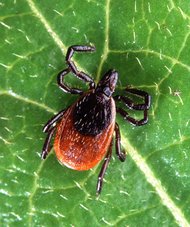When Antibiotics Fail: Lyme Disease and Rife Machines, with Critical Evaluation of Leading Alternative Therapies
by Bryan Rosner
ISBN 0-9763797-0-8
Available from: http://www.lymebook.com
Lyme Innovations Press, 2074 Lake Tahoe Blvd., Suite 6 South Lake Tahoe, California 96150 USA; 530-545-0309
Lyme Disease and Rife Machines, by Bryan Rosner, is a unique book that demonstrates what self-educated alternative health experts can do, but the billion dollar medical industry cannot or will not, do. An erudite balance between electro-medical, mainstream and alternative approaches in dealing with disease, the book is a profound piece of work that is sure to educate many readers regardless of whether or not one is interested in Lyme Disease.
The media, conventional health industry, and government all in tow by big pharma, have successfully brain washed many of us into believing we are incapable of thinking for ourselves. This devastating, paternal approach has squelched creativity and self-empowerment among sick and healthy people alike. The profitable system to control/hide symptoms of disease, rather than restoring the body's ability to heal and eliminate disease, has become the defining feature of modem, conventional medicine in the United States and Canada.
Bryan's book is a refreshing departure. His innovative methods for dealing with Lyme Disease are solidly based on the following statement from the book: "Actively participate in your healing journey--no one else will take responsibility for your treatment campaign except you ... a patient must be empowered and proactive during treatment."
This book is a real validation of electro-medical treatment: Lyme Disease is the ultimate test as it is one of the most difficult infections to eradicate. To date, this work provides the clearest understanding regarding use of electromagnetic therapies for this specific application. And, the book's information also applies to many other health conditions which Lyme Disease can stealthily mimic, such as Obsessive Compulsive Disorder, Multiple Sclerosis, Arthritis, Depression, Multiple Chemical Sensitivity, and more (a long list is in Appendix A). Bryan's book, which separates the wheat from the chaff, also includes extensive personal reports from dozens of Lyme Disease sufferers who have used Rife machines. Included also are instructions for accessing an online Lyme/Rife discussion group (membership is free) with over 1000 members.
Four primary Rife machines are discussed, along with a detailed explanation of the history of Rife therapy in the treatment of Lyme Disease. The introduction to the book includes sections about how long the recovery process is, mainstream vs. alternative medicine, and the story of Royal Raymond Rife. Supplemental graphs, charts and tables throughout the chapters drive home the book's concise theme.
More often than not, symptoms of disease are actually symptoms of nutrient deficiencies; hence, an enlightening discussion is aptly included. Of particular note, among others, is the significantly important role of magnesium and its association to disease. In this case, the Lyme Disease bacteria (unlike most bacteria which utilize iron in their lifecycle) requires magnesium to proliferate and thus causes a deficiency of it in the body.
In addition to the risk/reward analysis of Rife type devices (so one can come to their own conclusion), discussion is included focusing on practical applications of other therapies, such as hydrogen peroxide, homeopathy, colostrum, oxygen, ozone, hyperbaric oxygen chamber, and more. Also integrated is a thorough discussion of the important role and understanding of detoxification critical to any healing journey.
The following basically sums up the book (excerpt from the Preface): "I also heard people say that the placebo effect is responsible for Rife machine success against Lyme Disease. But where was the placebo effect when I failed to get benefit from so many other "proven" medical therapies? Why did the placebo effect show up and save the day all of a sudden, as soon as I tried Rife machines? After I started using Rife machines, the term "placebo effect" blended into the rest of the useless medical jargon I had heard from countless "experts" These supposed experts were really good at talking but really bad at offering any kind of solution. Rife machines offered me a workable solution. This book will give you the tools to come to your own conclusion."
review by Chris Gupta
Health Freedom Advocate, Canada
http://www.newmediaexplorer.org/chris/index.htm
chrisgupta@alumni.uwaterloo.ca
COPYRIGHT 2005 The Townsend Letter Group
COPYRIGHT 2005 Gale Group



